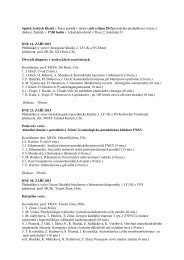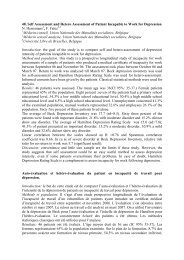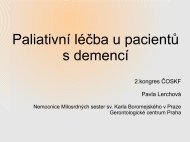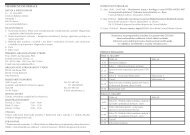ABSTRACTS â ORAL PRESENTATIONS - AMCA, spol. s r.o.
ABSTRACTS â ORAL PRESENTATIONS - AMCA, spol. s r.o.
ABSTRACTS â ORAL PRESENTATIONS - AMCA, spol. s r.o.
Create successful ePaper yourself
Turn your PDF publications into a flip-book with our unique Google optimized e-Paper software.
al., Adhesion molecule expression on peripheral blood mononuclear cells in rheumatoid<br />
arthritis: positive correlation between the proportion of L-selectin and disease activity.<br />
Clin Rheumatol, 1995. 14(3): p. 335-41.<br />
7. Tanaka, M., et al., Expansion of a unique macrophage subset in rheumatoid arthritis<br />
synovial lining layer. Clin Exp Immunol, 2008. 154(1): p. 38-47.<br />
8. Stuhlmuller, B., et al., CD11c as a transcriptional biomarker to predict response to<br />
anti-TNF monotherapy with adalimumab in patients with rheumatoid arthritis. Clin<br />
Pharmacol Ther, 2010. 87(3): p. 311-21.<br />
41. IMMUNOPHENOTYPE ANALYSIS OF NUCLEATED ERYTHROID PROGENITORS.<br />
APPLICATION OF OBTAINED RESULTS IN LEUKAEMIA DIAGNOSTICS<br />
Michaela Fajtová 1,2 , Anna Kovariková 1,2 , Jan Sedlák 1<br />
1<br />
Cancer Research Institute<br />
2<br />
Centre for Molecular Medicine, Slovak Academy of Sciences, Bratislava, Slovak<br />
Republic; e-mail: michaela.fajtova@savba.sk<br />
Introduction: Nucleated erythroid progenitors (NEPs) in normal regenerating bone<br />
marrow (BM) comprised of 4 developmental stages – pro-erythroblasts, basophilic<br />
erythroblasts, polychromatophilic erythroblasts, and orthochromatophilic erythroblasts.<br />
In clinical laboratories, the erythroid phenotype is conventionally characterised by the<br />
expression of CD36, CD71, and CD235a antigens, however the analysis of these antigens<br />
is not sufficient for the distinction of NEPs into 4 developmental stages. We supplemented<br />
previous NEP phenotype analysis (Wood, 2004) with the analysis of additional markers<br />
on NEPs, including CD105, CD117, CD45, CD38, we proposed NEPs gating strategy and<br />
determined the percentage of NEPs developmental stages in regenerating BM (Fajtova<br />
et al., 2013). The knowledge of exact erythroid phenotype is helpful for uncovering<br />
neoplastic erythroid population in diagnosis and follow-up of acute erythroid leukaemia<br />
(AML-M6) and myelodysplastic syndrome (MDS).<br />
Material and methods: NEPs phenotype was analysed on normal BM samples from 6<br />
non-leukemic and 14 leukemic patients (mainly B-ALL) in complete remission. Aberrant<br />
NEPs phenotype was analysed on BM samples from AML-M6 patients in diagnosis and<br />
follow-up. Flow cytometric measurement was performed on a BDCantoII Flow Cytometer<br />
using 6-colour staining. NEPs phenotype profile was examined with antibodies: anti-<br />
CD36-FITC, anti-CD36-FITC/CD235a-PE, anti-CD71-PE, anti-CD105-PerCP-Cy5.5, anti-<br />
CD34-PE-Cy7, anti-CD117-APC, anti-HLA-DR-FITC, anti-CD38-PE, anti-CD45-VioGreen<br />
and nucleic dye Syto.<br />
Results: All NEP developmental stages were gated as cells with the highest CD71 intensity<br />
and were stained with the nucleic acid dye Syto. Alternatively, NEPs in all stages could<br />
be also gated as CD36 + CD45 -/low Syto + cells, as CD45 -/low gating excluded the monocytic<br />
population and Syto + gating excluded the denucleated erythro debris (CD36 + Syto - ).<br />
CD36 + CD45 -/low Syto + gating is necessary in samples lacking CD71 antigen expression on<br />
NEP population.<br />
Analytical Cytometry VII 61








